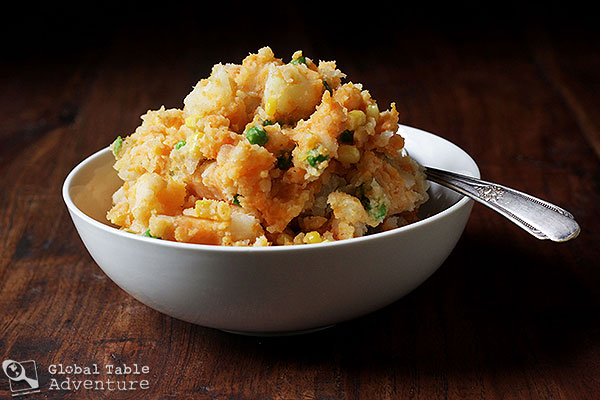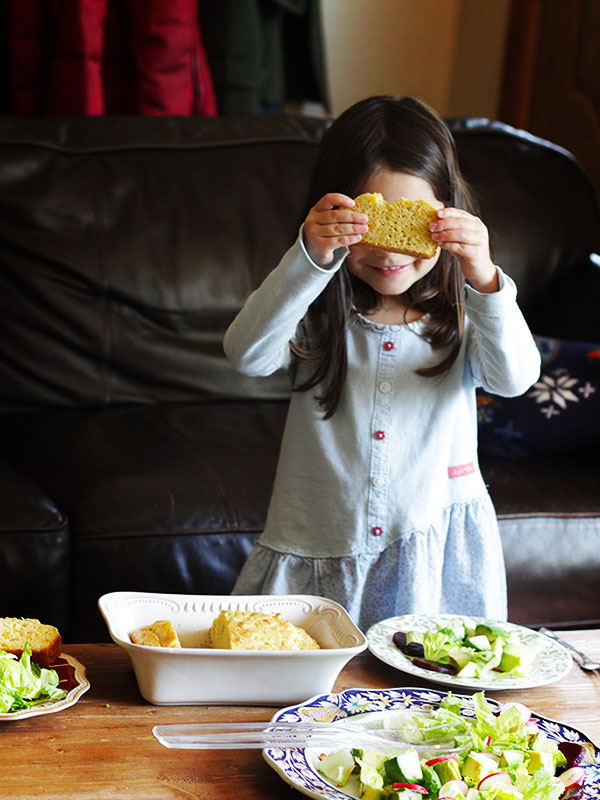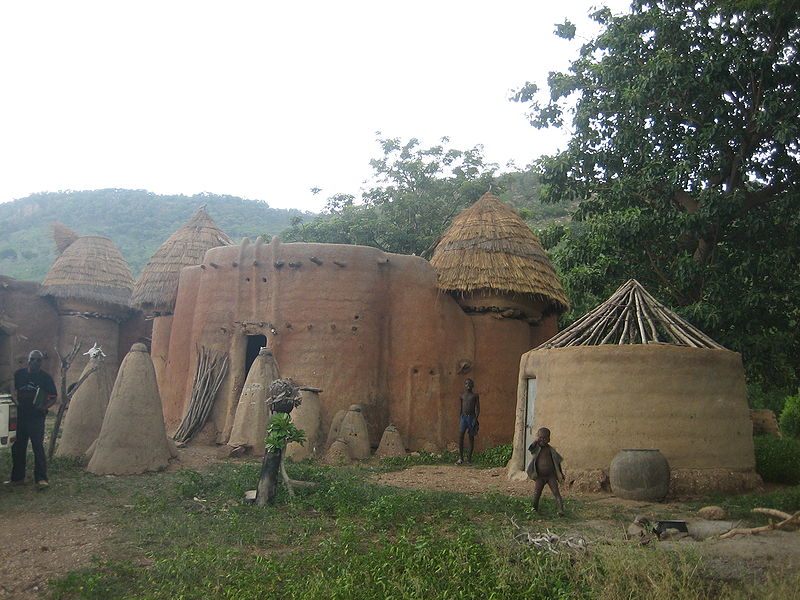
There’s an old Togolese proverb which says “Do not roast all your corn in the winter.” The proverb sums up Togo nicely. While the words point to importance placed on resourcefulness in this small, west African country, it also points to something much more obvious. The Togolese love their corn. As with most proverbs, they draw from the popular culture from whence they originate. This skinny strip of a country in western Africa really does love their corn, especially cornmeal. Cornmeal cakes called Djenkoume are a popular staple, as is fufu (stiff cornmeal porridge, although sometimes it is made with yam). Either might be served with chicken [like Grilled Togo Chicken], goat, or wild game. What does a Togolese person do when they tire of cornmeal? Eat cassava. It can be savory, on the side of goat stew, or an after dinner treat, served as a soft, sweet porridge. From the dry savannas and tropical coast, this land also loves their peanuts. In fact, groundnut stew [Recipe] (an old favorite from our Ghanaian Global Table), makes …
Read More

Moving Beyond Your Breaking Point Summer sweat is a near constant, now. I haunt my house, barefoot, draped in loose flowing dresses, completely aimless thanks to this seasonal fever. It’s all I can do to stay awake when the temperatures hit the nineties and the humidity approaches 100%. Eating Tanzania in this thick sort of summer heat was just perfect. All I had to do was close my eyes, and I was there. At least, I was there on the flatlands. But I wasn’t where I really, really wanted to be. Where I really wanted to be was Mount Kilimanjaro in northern Tanzania. Unlike the sizzling flatlands, Mount Kilimanjaro is covered with a perpetual blanket of snow. This epic mountain has fascinated me ever since I read about it in Michael Crichton’s book Travels. Have you read it? It is one of his least known books, but by-far my favorite because it covers Crichton’s globetrotting days. In the book, Michael Crichton attempts to climb Kilimanjaro. He approaches the mountain with all the swagger and arrogance of someone who’s …
Read More
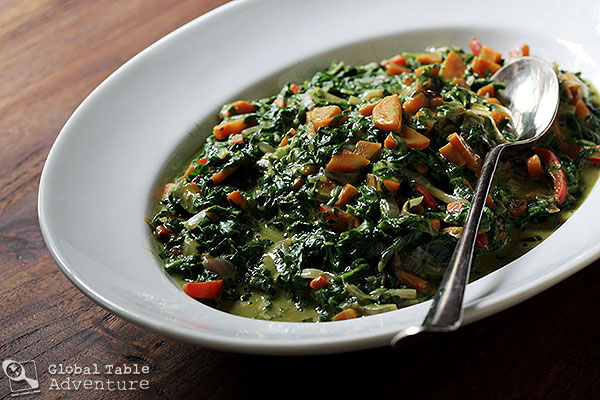
When my neighbor Jonathan told me he craves Kisamvu for weeks after his visits to Tanzania, I knew I had to try it. Kisamvu is just another word for cassava leaves, but Jonathan tells me he uses spinach whenever he’s in the states and the taste is a very good approximation. Jonathan gave me the very recipe they use at the orphanage he visited in Tanzania, called the Janada Batchelor Foundation for Children. While there, he films documentary footage to help promote the good work they JBFC does with his production company called RTC Pictures… What a fun gig! Now about that recipe… There are no exact measurements, although I did have the pleasure of watching the “Mamas” make a huge batch of kisamvu in his video footage (Mamas are the ladies in charge of the children). They do everything from build and stoke the kitchen fires (which are built under three large stones. The stones hold the pot). They also chop wood and cook the food. And the food comes straight from their gardens, moments …
Read More
I’m a little like mashed potatoes; I’m stable and sure, but I avoid wearing colorful makeup. The last time I wore blue eye liner was the nineties, and it was already a decade too late. I’m destined to recede behind more vibrant individuals – individuals of style. But imagine what good things could come from a splash of color? The jury is out with me, but consider the mashed potato. Must she remain the unadorned, pale wallflower in a buffet of color? Tanzania teaches that this doesn’t have to be so… Enter the rainbow known as Irio, a Kikuyu dish found in Kenya, Tanzania, and Uganda. Irio simply means “mashed” – a concoction of whatever tubers and vegetables the cook wants to pull together for an easy dinner. Most often, Irio is a combination of white potato, peas, and corn, but green beans, carrots, shredded spinach, or other veggies can also play star roles. Depending on how Irio is mixed, the mash might be sunset orange, or new leaf green. For me, it was …
Read More

“The roaring lion kills no game” Tanzanian Proverb In honor of this all-too true saying from Tanzania, we’re going all veggie this week. Truth is, I’ve been doing my fair share of ‘roaring’, which leaves me with a deficit of time for anything but quick (but fun!) dishes. Veggies fit the bill rather perfectly. In fact, our menu feels like a bulletin from Smokey the Bear, but without fires… and lots of veggies… “Thanks to Tanzania, you, too, can prevent veggie boredom!” Whether you’re tossing corn and peas in your mashed potatoes, or stirring peanut butter and coconut milk into your leafy greens, Tanzania definitely steps up with fresh ideas for your weeknight side dishes. All recipes and the meal review will be posted throughout the week. Greens with veggies & Peanuts | Kisamvu [Recipe] This vegan treat is inspired straight from the heart of Tanzania; enjoy spinach cooked with carrot, onion, pepper, and a creamy, tantalizing blend of peanut butter and coconut milk. Mashed Potatoes with Veggies | Irio [Recipe] Turn boring mashed potatoes …
Read More

A few months ago, my next door neighbor, Jonathan, told me he was going to Tanzania to shoot documentary footage at an orphanage in Tanzania. “Your going to Tanzania?!” I exclaimed, thrilled with the serendipity of the situation, “Tell me all about the food – what do the children eat?” Over the next several minutes, he enthusiastically described the food of this east African country, possibly most well-known for the breathtaking peak of Mount Kilimanjaro. (Incidentally, if you ever get the chance to read the autobiographical book Travels, by Michael Crichton, you’ll find a wonderful passage about his hike to the summit of this great mountain). He said, while the food itself is simple, even outside of the orphanage, it remains utterly craveable. There’s an old Tanzanian saying that states “Little by little, a little becomes a lot.” And so it is with the food. Even when there is a little, if it is good and the supply keeps coming, it fills the heart and belly to capacity. The first food Jonathan mentioned was ugali, the white …
Read More
“The bee that is forced into the hive will not produce honey.” This Swazi proverb has me thinking about what I do and why. When I used to work a desk job, I had a palpable limit to my energy and creativity: it was called “5pm.” The old song “It’s five o’clock somewhere” was my quitting time rhyme. I was out that door faster than anyone else and, in fact, I was unproductively waiting for the end of the day even before five o’clock. But since I began cooking the world, something strange has happened. No longer am I watching the clock. No longer do I count the minutes down by the second. Instead, I have weeks like this one… our Swazi week … where I’m surrounded by the steam of the moistest corn bread I’ve ever had, reveling as I eat nearly an entire loaf by myself. Times when I fall into a tongue in cheek discussion with Mr Picky about how delicious beets are (I believe it, he doesn’t). Where Ava tries …
Read More

Swaziland’s swooping slopes are dotted with crops; it is here that the Swazi grow the freshest produce, from sunshine yellow lemons, to buttery avocados. With farming of that caliber, it should come as no surprise that Swazi Salads are especially grand. This is not to say they are carefully composed salads. (Most things that are careful, aren’t nearly as delicious.) No, these are simple, heaped piles of chopped veggies. But you can get them on the side of even the most humble plate of beans, which counts for, well, everything. There’s no elaborate dressing, save, perhaps, a squeeze of lemon juice and fresh grated ginger. Croutons? Forget it. The crunch you seek comes from a handful of crushed peanuts and the crisp bite of a sharp radish. Feeling bold? Add minced hot peppers to that lemon juice. Fresher and brighter is the name of the game. So what’s in a Swazi Salad? Every time I looked up Swazi salads, I happened across some combination of avocado, lettuce, onion, and beets. Beets were everywhere: red heaped piles …
Read More
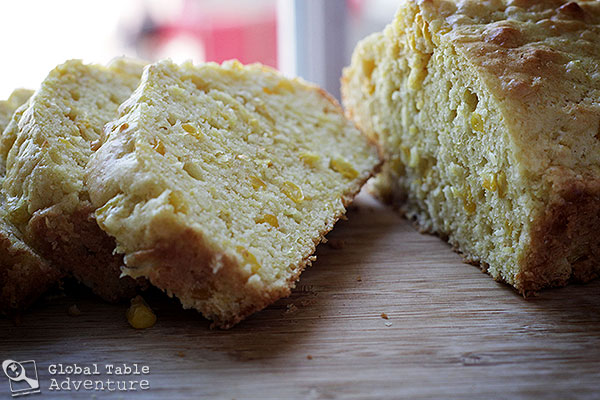
The next time you walk into your kitchen, walk into the warm, sweet scent of mealie bread. Let a smile curl along your lips as you taste that first, moist bite with your imagination. Then take a moment for real indulgence: spread softened butter across the still-warm bread, only to see it melt into and down the sides of the tender crumb. I’ve had lots of corn bread before, but never something as rich and flavorful as this Mealie Bread. The main difference between this and ordinary corn bread is that it doesn’t rely on cornmeal, but actual corn to flavor the bread. Mealie Bread is a treat you will find throughout southern Africa. In olden days, it was steamed over a campfire, with little more than ground corn, wrapped up in husks. They used white corn, not sweet, yellow corn. The end result was more of a wet corn pudding. Today’s southern Africans, however, love mealie bread with more of a bread consistency, so they include flour. The jury is out, however, on whether or not the …
Read More
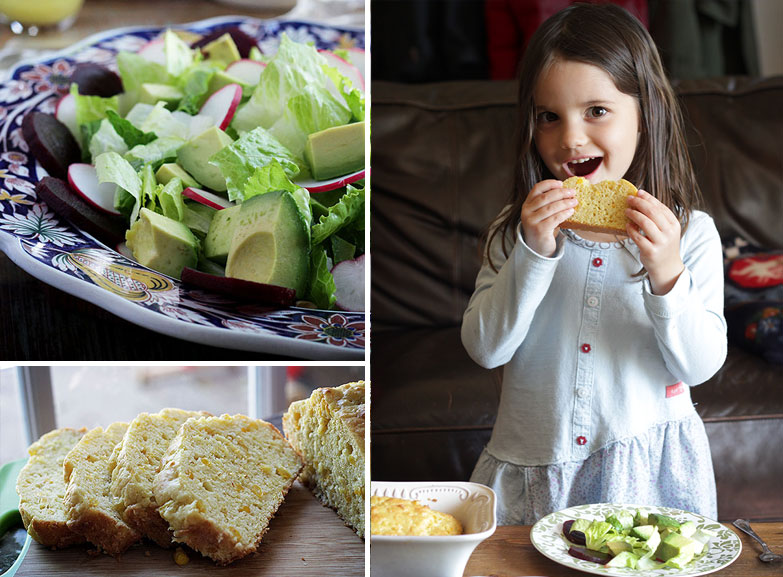
There’s an old Swazi saying that goes: “A man who prides himself on his ancestry is like the potato plant, the best part of which is underground.” Do you agree? Do we need to know our ancestors?* And are they the best part of who we are? Once upon a time, we got our recipes from our ancestors. Grandma’s cornbread. Uncle’s avocado salad. Today we can find just about anything online, but the best recipes come from someone … from the long line of way back when. They’ve been tested and tried, adapted and improved upon. This week’s recipes are inspired by the Swazi people (and beyond that, too, these are staple ingredients and recipes popular throughout most of Southern Africa). The ingredients are nod to fresh produce and the transition between winter and spring, which, like the alarm clock, keeps resetting (It’s 42F, right now, after an 80F weekend). The cornbread, as you’ll learn when the recipe posts, has undergone many changes over the years, to reach its straightforward, delicious self. Sometimes I dream about living on a farm …
Read More

This week we’re back in Africa, in a little tropical/temperate country called Swaziland, just north of South African and Lesotho. The Swazi people live in this beautiful land, among the mountains and undulating hills, tending their farms and rearing their cattle. From their smooth slopes, come pineapples, citrus, and sweet sugar cane. Many call Swaziland one of the world’s most beautiful countries, and I can see why. While the traditional people might eat something as simple as emasi, or porridge, which can be made with sorghum or corn, you’ll also find corn, rice, and every kind of potato, including sweet potato. Many stews, such as spinach, pumpkin, or even green beans, grace the sides of such dishes. Salads are a given, especially when topped with avocado or beets [Recipe]. And did you know the Swazi eat beer? That’s right… beer is yet another carb; the Swazi consider their rich, thick home brew a food. (I read about it in the World Cookbook for Students.) If that’s too boozy for you, perhaps a simple slice of mealie bread [Recipe] (think corn bread with bolder, …
Read More

What is a celebrity? One definition is someone who commands “public fascination.” Could this be the profile of one such person? This week we shared our meal with a very special guest; someone who has actually traveled to South Sudan, slept in their huts, hunted in their forests, and enjoyed feasts while sitting at the right hand of the village Chief. I’d tell you when all this happened, but I’ve been sworn to secrecy. I’ve wanted to invite this man to our table for a long time, partly because he is so passionate about the cultures of the world, but also because anywhere he goes, he comes back with stories. Enough to fill a 450 page book, actually. Say ‘hello’ to Brian Schwartz. You might recognize him from his lengthy, insightful comments… He’s been sharing them from the very beginning of this blog. Without him, my adventures into Africa and parts of Asia would have been much quieter, but his memories (and music!) have livened up our stovetop travels … making me (and I’m sure …
Read More




